
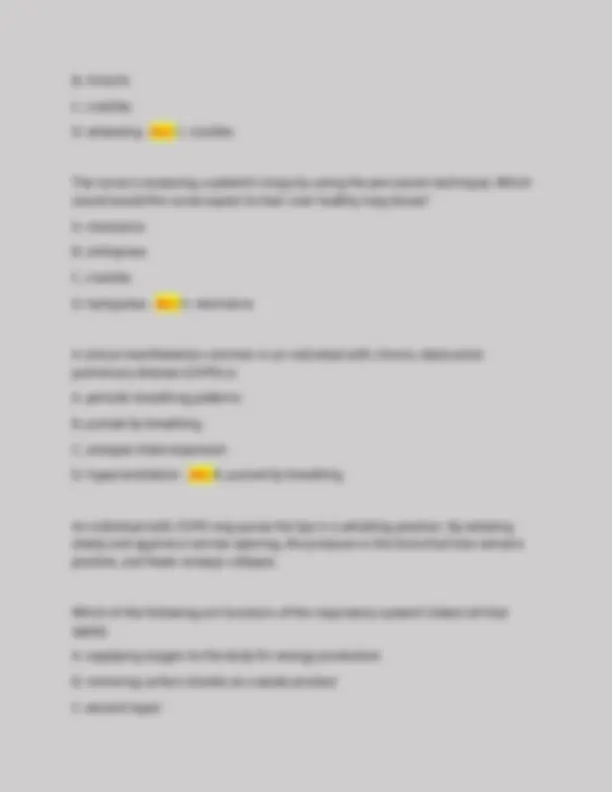
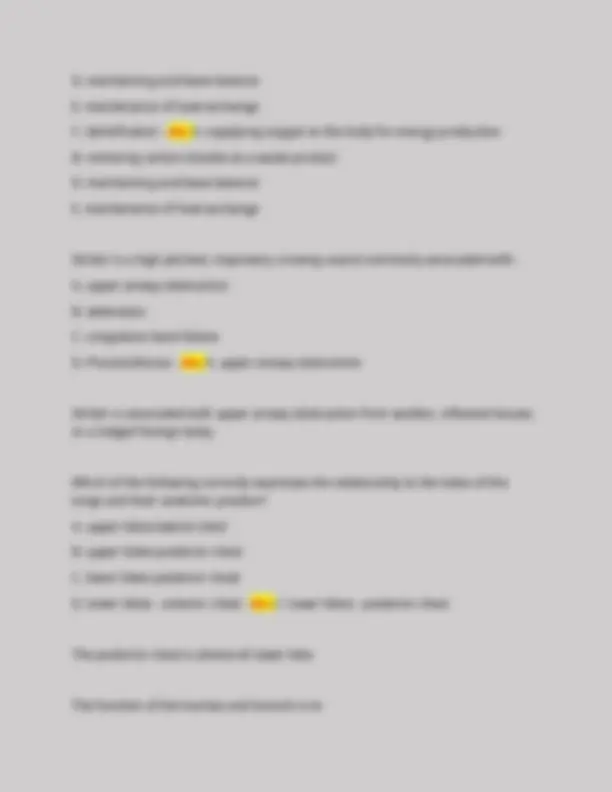
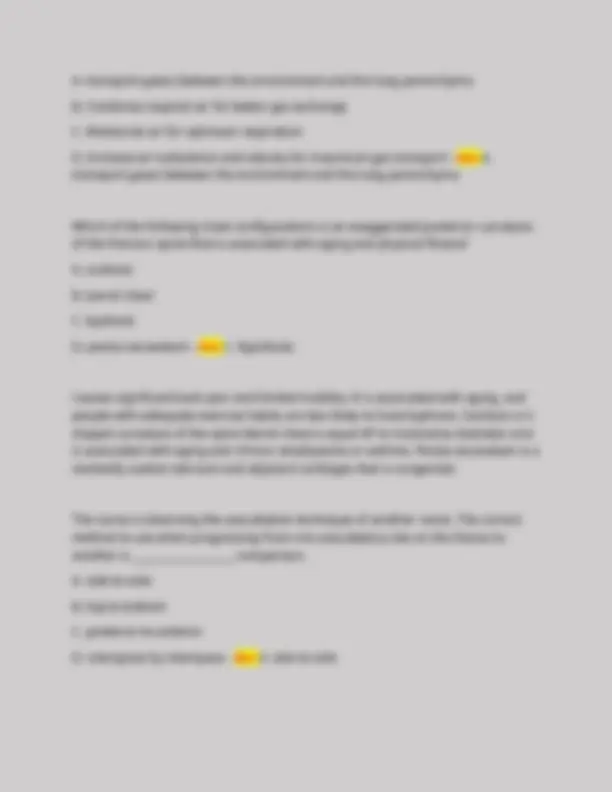
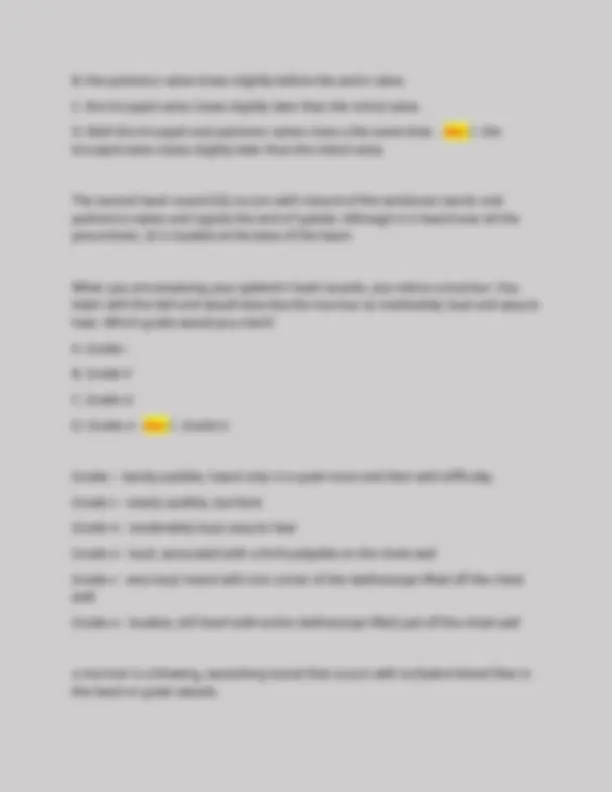
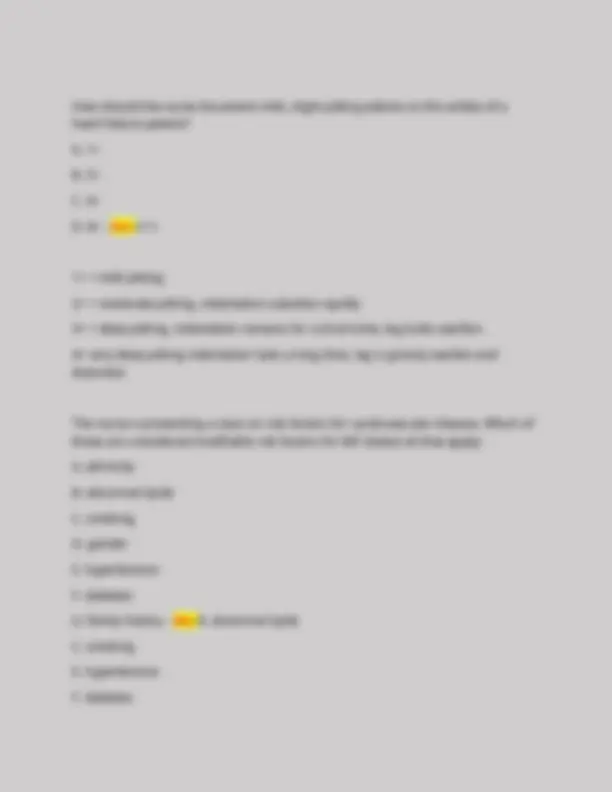
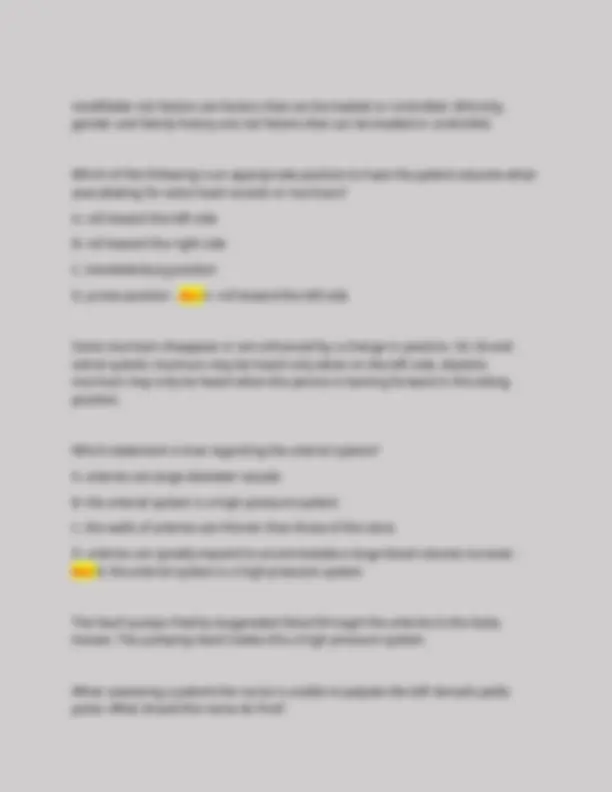

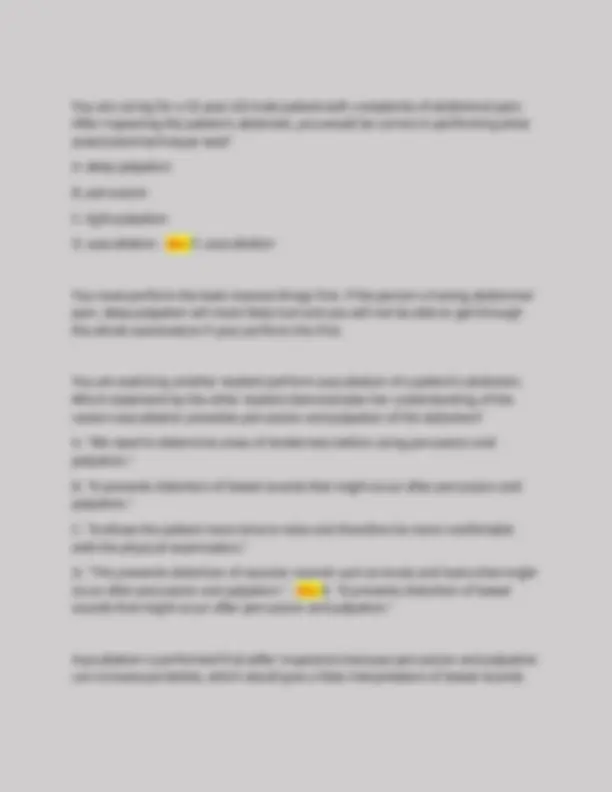
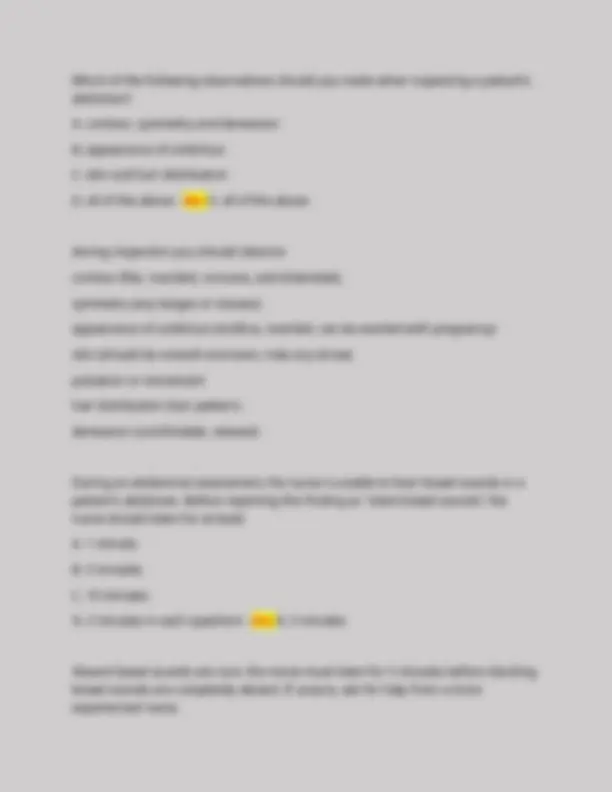
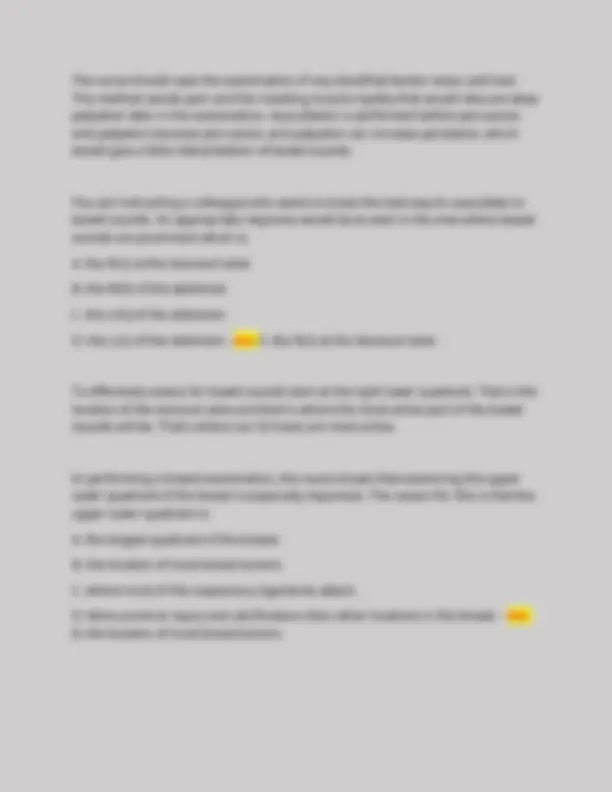
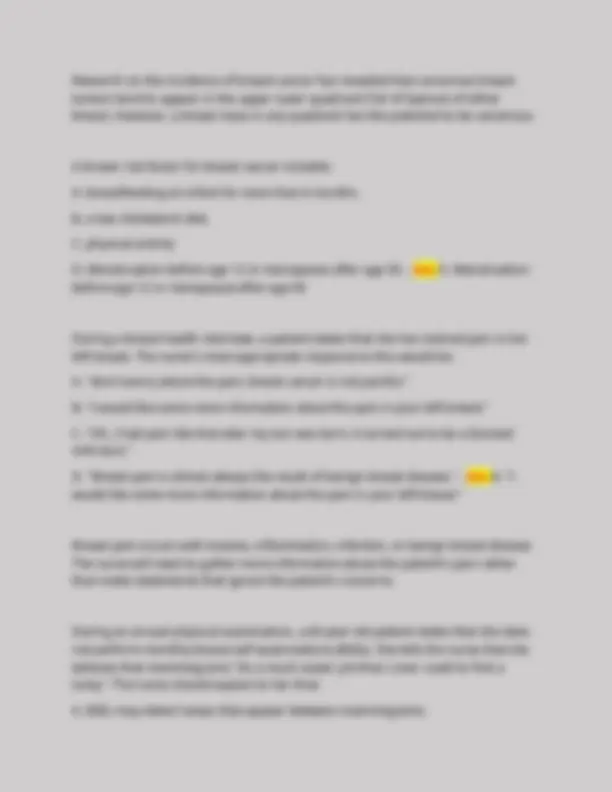
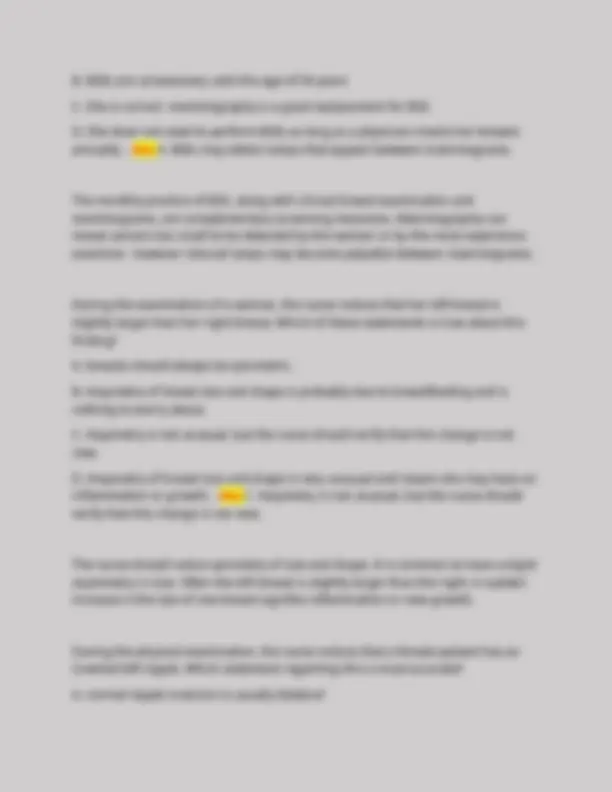
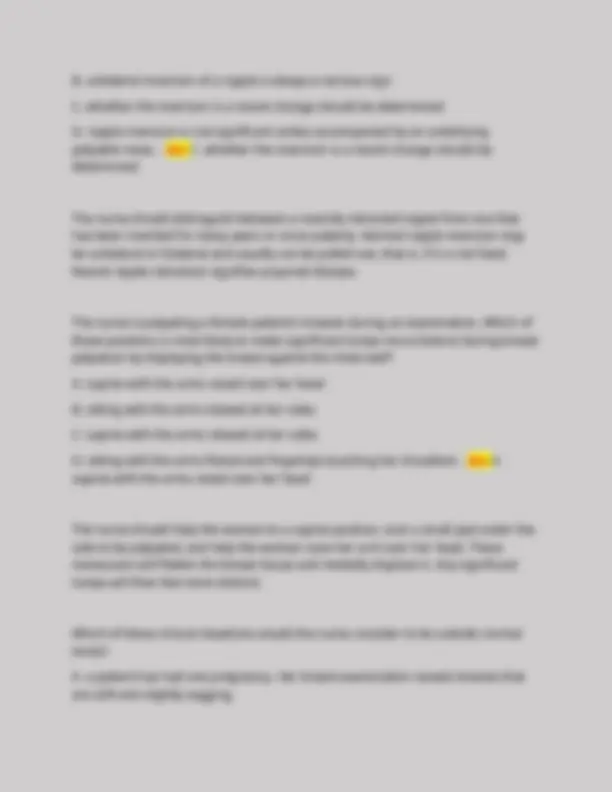
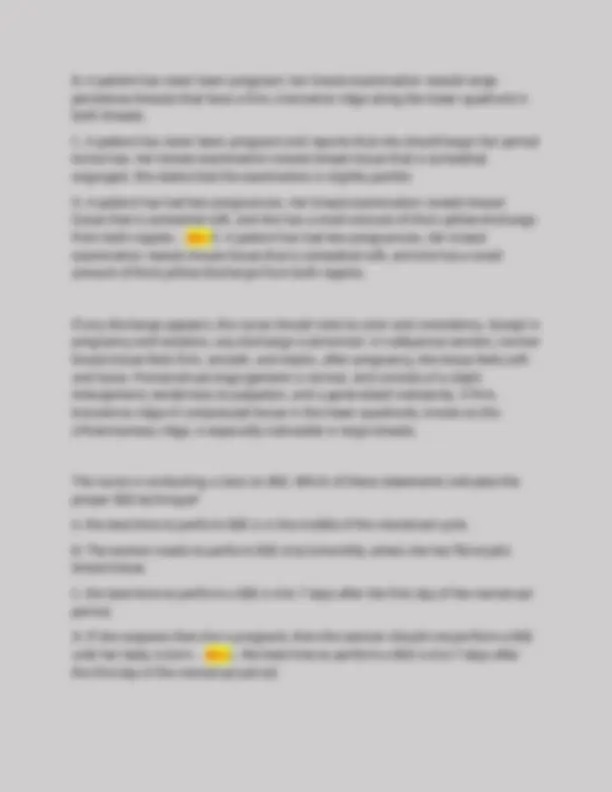
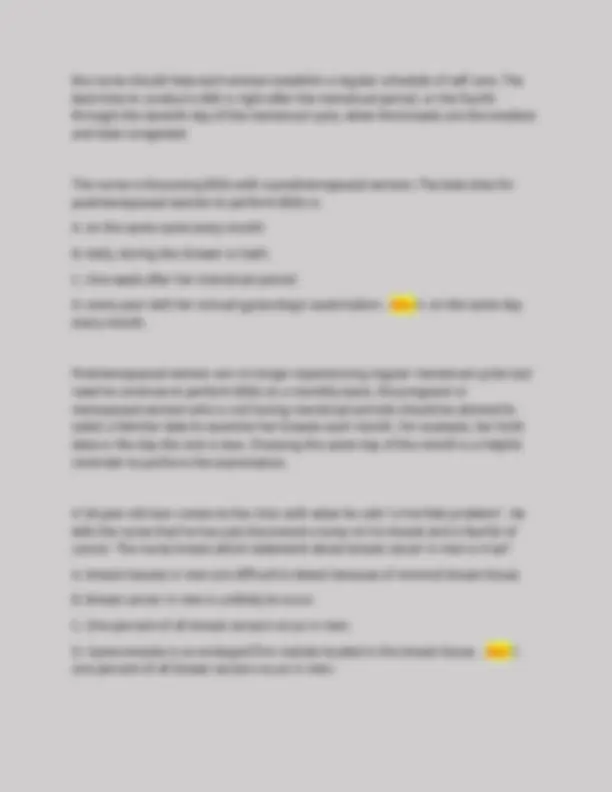

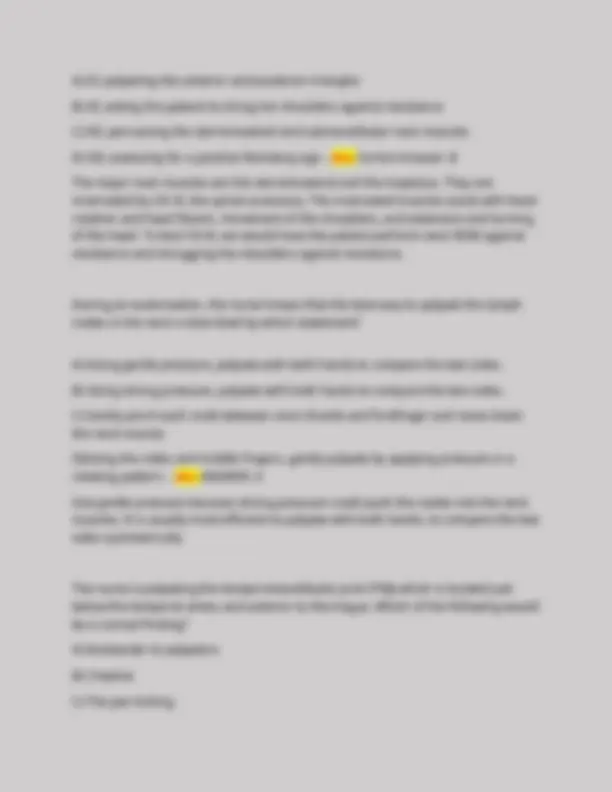
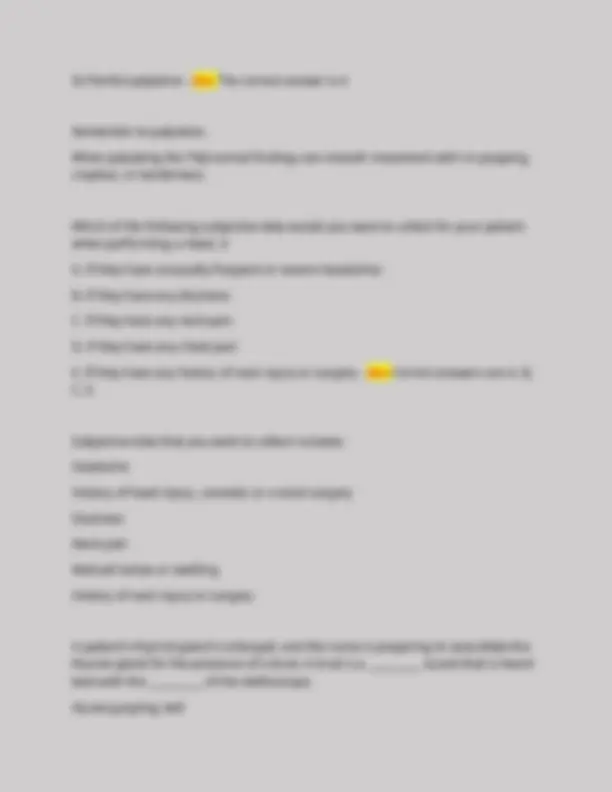
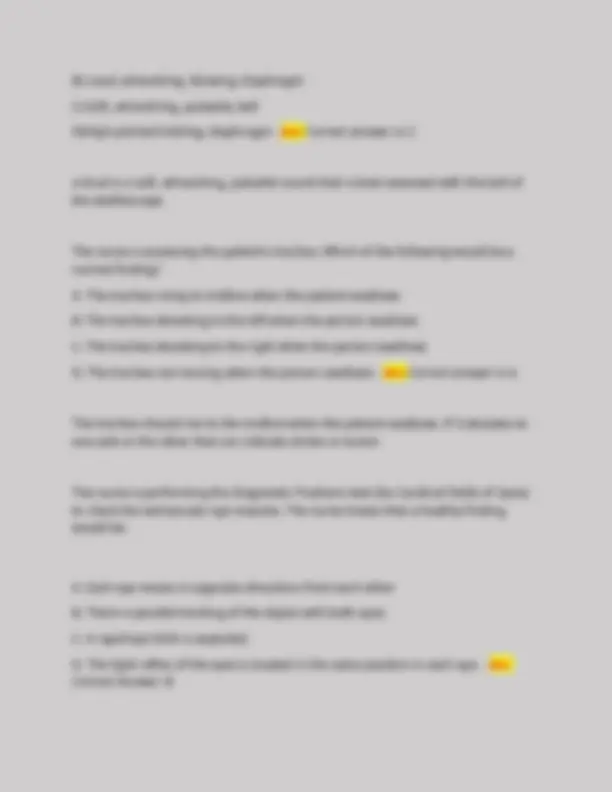
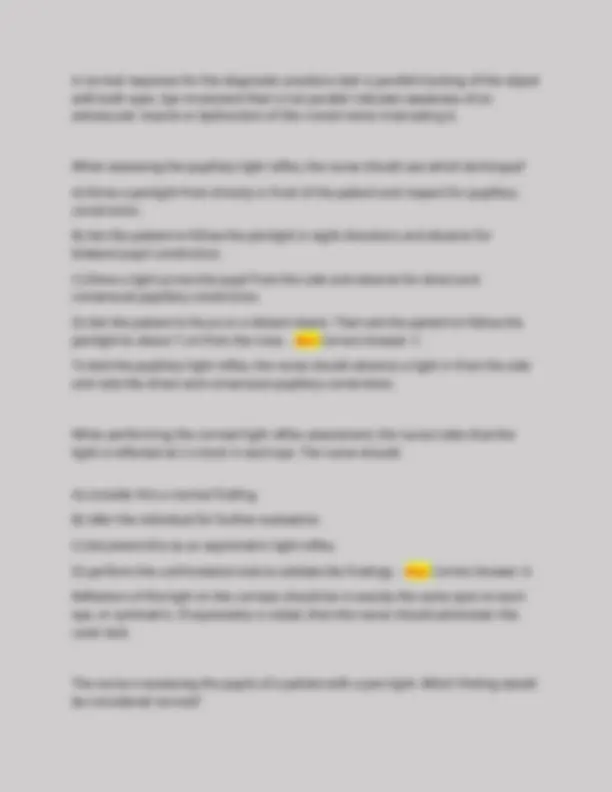
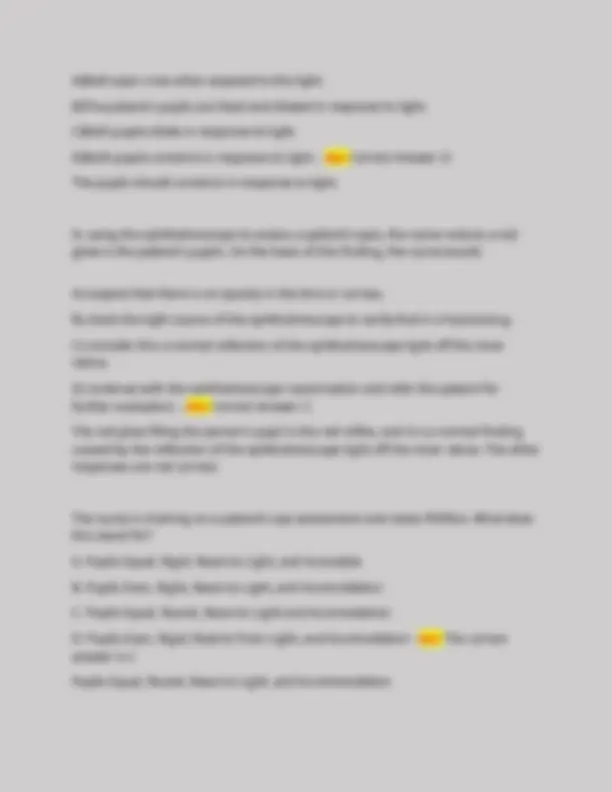
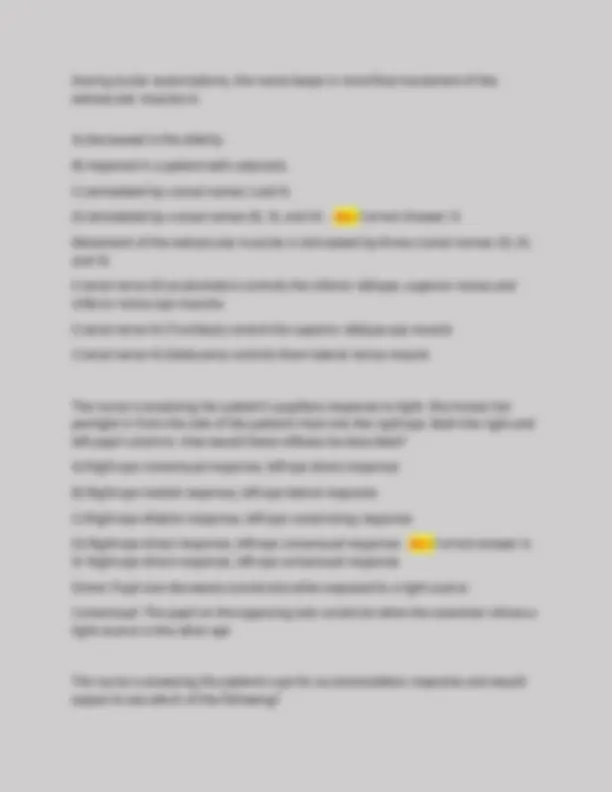
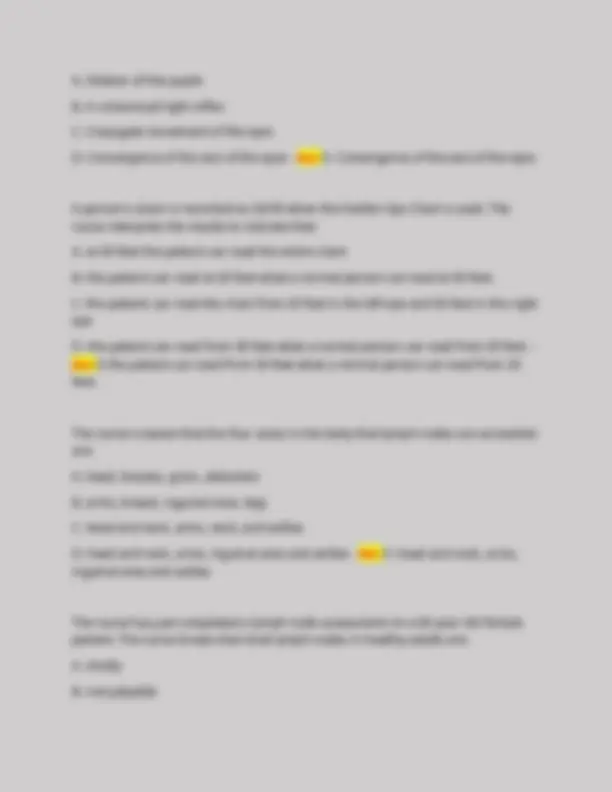
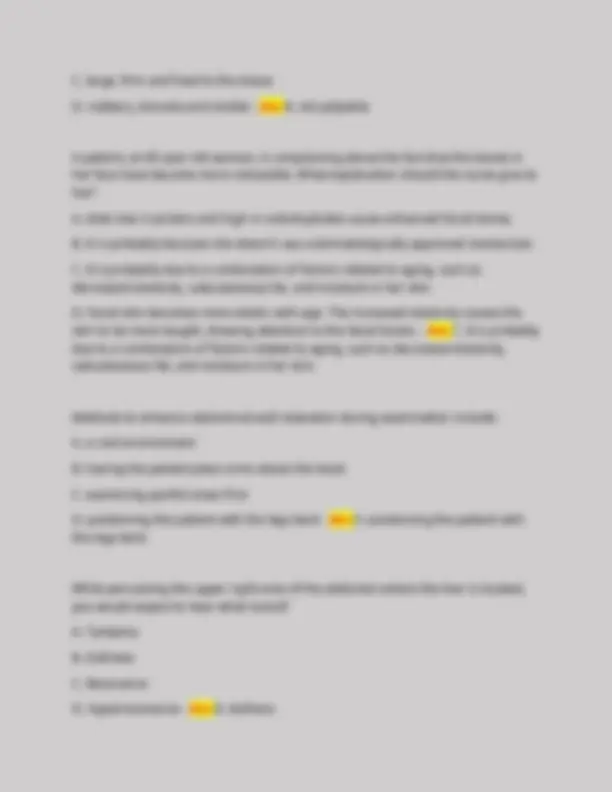
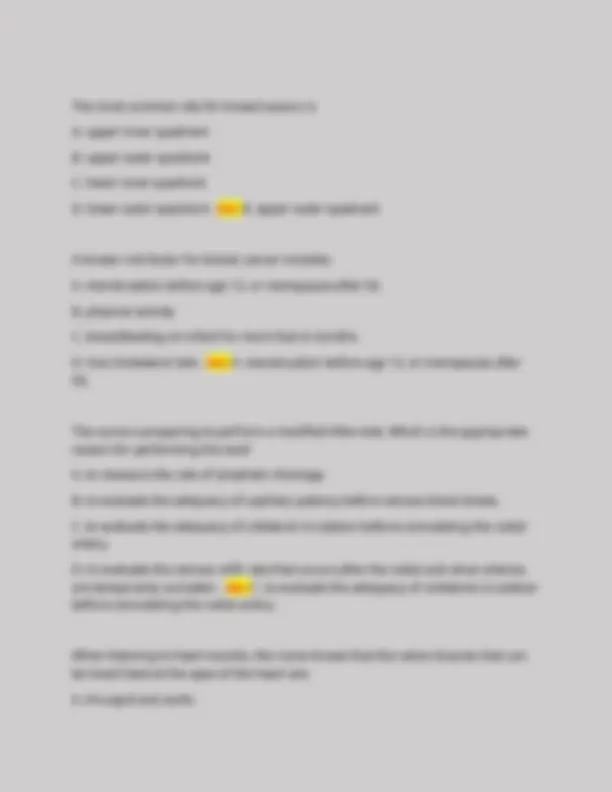
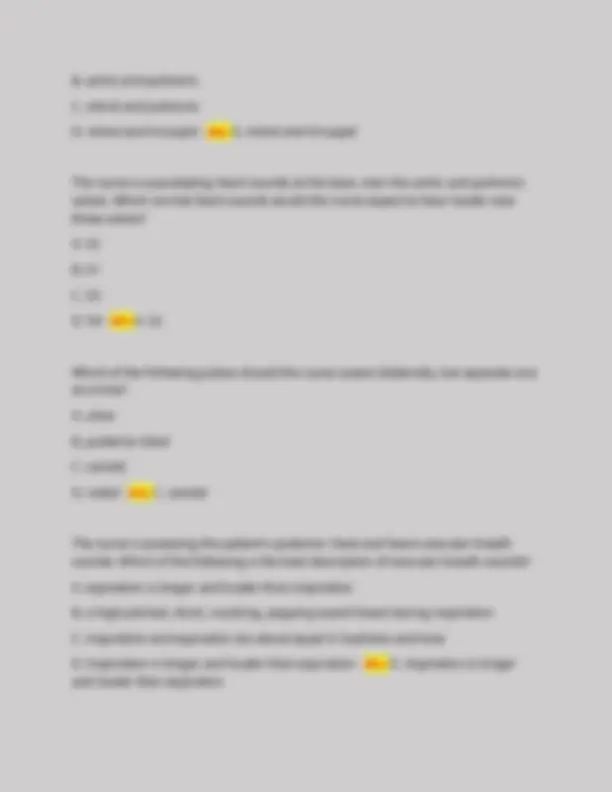
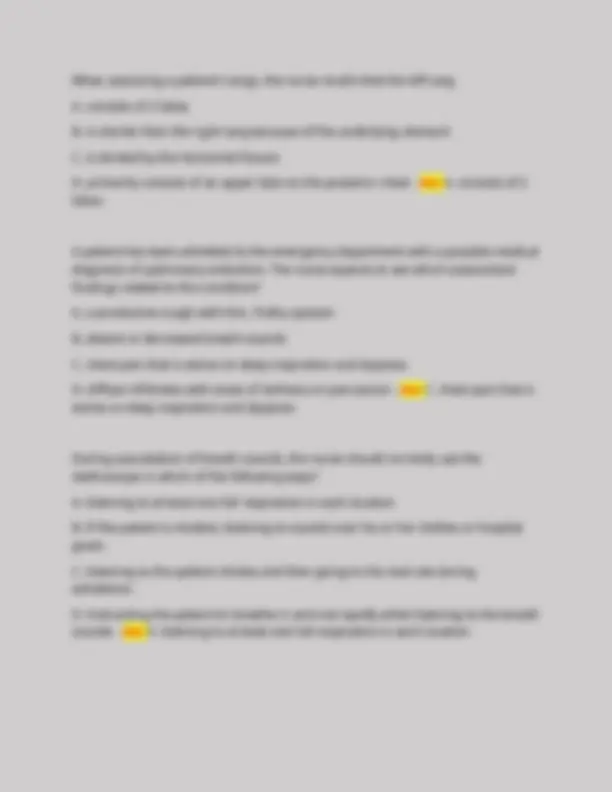


Study with the several resources on Docsity

Earn points by helping other students or get them with a premium plan


Prepare for your exams
Study with the several resources on Docsity

Earn points to download
Earn points by helping other students or get them with a premium plan
Community
Ask the community for help and clear up your study doubts
Discover the best universities in your country according to Docsity users
Free resources
Download our free guides on studying techniques, anxiety management strategies, and thesis advice from Docsity tutors
A comprehensive review of health assessment techniques related to the cardiopulmonary system. It includes questions and answers covering topics such as auscultation, percussion, and palpation, as well as conditions like pneumonia, emphysema, and copd. The material is designed to help students understand key concepts and clinical manifestations associated with respiratory and cardiovascular health. It also covers the interpretation of lung sounds, heart sounds, and other assessment findings, making it a valuable resource for medical and nursing students. This review is particularly useful for exam preparation and clinical practice.
Typology: Exams
1 / 35

This page cannot be seen from the preview
Don't miss anything!




























A palpable vibration increased with lobar pneumonia is also known as: A. Rhonchi B. Resonance C. Fremitus D. Crackles - Ans C. Fremitus (key term is "palpable" Your patient is exhibiting rapid shallow breathing, with a respiratory rate > respirations per minute. Which of the following conditions are they experiencing? A. hypoxemia B. tachypnea C. fremitus D. resonance - Ans B. tachypnea Increased tactile fremitus would be evident in an individual who has which of the following conditions? A. emphysema B. pneumonia C. crepitus D. pneumothorax - Ans B. pneumonia Fremitus is a palpable vibration. Increased fremitus occurs with compression or consolidation of lung tissue (ex. lobar pneumonia)
Which of the following terms is used to describe a decreased level of oxygen (O2) in the blood? A. anemia B. hypercapnia C. hypoxemia D. emphysema - Ans C. hypoxemia The nurse is assessing a patient who has emphysema. They note a course, crackling sensation that is palpable over the skin surface. This is known as: A. hypoxemia b. crackles C. fremitus D. crepitus - Ans D. crepitus Upon receiving the patient's lab results, the nurse notes the patient has an increased level of carbon dioxide in the blood. Which of the following conditions would the patient be experiencing? A. resonance B. hypercapnia C. fremitus D. tachypnea - Ans B. hypercapnia The nurse is auscultating a patient's lungs and hears discontinuous, high-pitched, short, popping sounds heard during inspiration, and not cleared by coughing. These are described as: A. bradypnea
D. maintaining acid-base balance E. maintenance of heat exchange F. identification - Ans A. supplying oxygen to the body for energy production B. removing carbon dioxide as a waste product D. maintaining acid-base balance E. maintenance of heat exchange Stridor is a high pitched, inspiratory crowing sound commonly associated with: A. upper airway obstruction B. atelectasis C. congestive heart failure D. Pneumothorax - Ans A. upper airway obstruction Stridor is associated with upper airway obstruction from swollen, inflamed tissues or a lodged foreign body. Which of the following correctly expresses the relationship to the lobes of the lungs and their anatomic position? A. upper lobes-lateral chest B. upper lobes-posterior chest C. lower lobes-posterior chest D. lower lobes - anterior chest - Ans C. lower lobes - posterior chest The posterior chest is almost all lower lobe The function of the trachea and bronchi is to
A. transport gases between the environment and the lung parenchyma B. Condense inspired air for better gas exchange C. Moisturize air for optimum respiration D. Increase air turbulence and velocity for maximum gas transport - Ans A. transport gases between the environment and the lung parenchyma Which of the following chest configurations is an exaggerated posterior curvature of the thoracic spine that is associated with aging and physical fitness? A. scoliosis B. barrel chest C. kyphosis D. pectus excavatum - Ans C. Kypohosis Causes significant back pain and limited mobility. It is associated with aging, and people with adequate exercise habits are less likely to have kyphosis. Scoliosis is S shaped curvature of the spine Barrel chest is equal AP to transverse diameter and is associated with aging and chronic emphysema or asthma. Pectus excavatum is a markedly sunken sternum and adjacent cartilages that is congenital. The nurse is observing the auscultation technique of another nurse. The correct method to use when progressing from one auscultatory site on the thorax to another is ___________________ comparison. A. side-to-side B. top-to-bottom C. posterior-to-anterior D. interspace by interspace - Ans A. side to side
B. Right atrium, right ventricle, pulmonary artery, lungs, pulmonary vein, left atrium, left ventricle C. Aorta, right atrium, right ventricle, lungs, pulmonary vein, left atrium, left ventricle, vena cava D. right atrium, right ventricle, pulmonary vein, lungs, pulmonary artery, left atrium, left ventricle - Ans B. Right atrium, right ventricle, pulmonary artery, lungs, pulmonary vein, left atrium, left ventricle Returning blood from the body empties into the right atrium from the superior vena cava (SVC) and inferior vena cava (IVC), and flows into the right ventricle and then goes to the lungs through the pulmonary artery. The luns oxygenate the blood and it is then returned to the left atrium by the pulmonary vein. it goes from there to the left ventricle and then out of the body through the aorta. When listening to heart sounds, the nurse knows that the valve closures that can be heard best at the base of the heart are: A. mitral and tricuspid B. tricuspid and aortic C. aortic and pulmonic D. mitral and pulmonic - Ans C. aortic and pulmonic Events occur just slightly later in the right side of the heart because of the route of myocardial depolarization. As a result, two distinct components to each of the heart sounds exist, and sometimes they can be heard separately. In the first heart sound, the mitral component (MI) closes just before the tricuspid component (T1) Which of these statements describes the closure of the valves in a normal cardiac cycle? A. the aortic valve closes slightly before the tricuspid valve.
B. the pulmonic valve closes slightly before the aortic valve. C. the tricuspid valve closes slightly later than the mitral valve. D. Both the tricuspid and pulmonic valves close a the same time. - Ans C. the tricuspid valve closes slightly later than the mitral valve. The second heart sound (S2) occurs with closure of the semilunar (aortic and pulmonic) valves and signals the end of systole. Although it is heard over all the precordium, S2 is loudest at the base of the heart. When you are assessing your patient's heart sounds, you notice a murmur. You listen with the bell and would describe the murmur as moderately loud and easy to hear. Which grade would you chart? A. Grade i B. Grade V C. Grade iii D. Grade vi - Ans C. Grade iii Grade i - barely audible, heard only in a quiet room and then with difficulty. Grade ii - clearly audible, but faint Grade iii - moderately loud, easy to hear Grade iv - loud, associated with a thrill palpable on the chest wall Grade v - very loud, heard with one corner of the stethoscope lifted off the chest wall. Grade vi - loudest, still heart with entire stethoscope lifted just off the chest wall a murmur is a blowing, swooshing sound that occurs with turbulent blood flow in the heart or great vessels.
modifiable risk factors are factors that can be treated or controlled. Ethnicity, gender and family history are not factors that can be treated or controlled. Which of the following is an appropriate position to have the patient assume when auscultating for extra heart sounds or murmurs? A. roll toward the left side B. roll toward the right side C. trendelenburg position D. prone position - Ans A. roll toward the left side Some murmurs disappear or are enhanced by a change in position. S3, S4 and mitral systolic murmurs may be heard only when on the left side. diastolic murmurs may only be heard when the person is leaning forward in the sitting position. Which statement is true regarding the arterial system? A. arteries are large-diameter vessels B. the arterial system is a high-pressure system C. the walls of arteries are thinner than those of the veins D. arteries can greatly expand to accommodate a large blood volume increase - Ans B. the arterial system is a high-pressure system The heart pumps freshly oxygenated blood through the arteries to the body tissues. The pumping heart makes this a high pressure system. When assessing a patient the nurse is unable to palpate the left dorsalis pedis pulse. What should the nurse do first?
A. document the finding B. use the doppler to assess the pulse C. call the physician and tell them the patient has no pulse. D. start assessing the next patient - Ans B. use the doppler to assess the pulse The first thing that you should do is find a doppler and see if the pulse can be heard through ultrasound Pulse rating system: O = absent 1+ = weak 2+ = normal 3+ increased, full, bounding A 67-year old patient states that he recently began to have pain in his left calf when climbing the 10 stairs to his apartment. This pain is relieved by sitting for approximately 2 minutes; then he is able to resume his activities. the nurse interprets that this patient is most likely experiencing: A. intermittent claudication. B. sore muscles C. muscle cramps D. venous insufficiency - Ans A. intermittent claudication The pain is brought on by activity and relieved with rest. The nurse is preparing to perform a modified Allen test. Which is an appropriate reason for this test?
When auscultating over a patient's femoral arteries, the nurse notices the presence of a bruit on the left side. The nurse knows that bruits A. are often associated with venous disease B. occur in the presence of lymphadenopathy C. in the femoral arteries are caused by hypermetabolic states D. occur with turbulent flow, indicating partial occlusion - Ans D. occur with turbulent flow, indicating partial occlusion Bruits occur with turbulent blood flow, indicating partial occlusion. A bruit is audible when the artery is occluded by 1/2 to 2/3, it's loudness increases as atherosclerosis worsens and disappears when the lumen is completely occluded You are caring for a 36 year old female patient admitted with c/o nausea and vomiting (N/V). What questions are appropriate to ask the patient to elicit health history information regarding her GI system? A. any changes in bowel habits? B. how long have you experienced this N/V? C None of the above. D. both a and b. - Ans D. both A and B These are examples of subjective data obtained to elicit GI history True or false? A 24-hour recall of dietary intake is considered subjective data collected during a GI assessment. - Ans True You would want to know what the patient has eaten for the last 24 hours to determine if his or her symptoms have to do with what they have eaten in their daily diet.
You are caring for a 32 year old male patient with complaints of abdominal pain. After inspecting the patient's abdomen, you would be correct in performing what assessment technique next? A. deep palpation B. percussion C. light palpation D. auscultation - Ans D. auscultation You must perform the least invasive things first. if the person is having abdominal pain, deep palpation will most likely hurt and you will not be able to get through the whole examination if your perform this first. You are watching another student perform auscultation of a patient's abdomen. Which statement by the other student demonstrates her understanding of the reason auscultation precedes percussion and palpation of the abdomen? A. "We need to determine areas of tenderness before using percussion and palpation." B. "It prevents distortion of bowel sounds that might occur after percussion and palpation." C. "It allows the patient more time to relax and therefore be more comfortable with the physical examination." D. "This prevents distortion of vascular sounds such as bruits and hums that might occur after percussion and palpation." - Ans B. "It prevents distortion of bowel sounds that might occur after percussion and palpation." Auscultation is performed first (after inspection) because percussion and palpation can increase peristalsis, which would give a false interpretation of bowel sounds.
Methods to enhance abdominal wall relaxation during examination include: A. positioning the patient with the knees bent B. examining painful areas first. C. having the patient place arms above the head D. a cool environment - Ans A. positioning the patient with the knees bent Bending the knees promotes abdominal muscle relaxation. Painful areas should be examined last to avoid muscle guarding. Avoid having arms above the head; this increases abdominal wall tension. Keep the room warm to avoid chilling and tensing of muscles The nurse is aware that one change that may occur in the gastrointestinal system of an aging adult is: A. increased salivation. B. increased liver size. C. increased esophageal emptying D. decreased gastric acid secretion - Ans D. decreased gastric acid secretion Gastric acid secretion decreases with aging. As one ages, salivation decreases, esophageal emptying is delayed, and liver size decreases. The nurse is performing percussion during an abdominal assessment. She taps on the patient's left upper quadrant (spleen) and right upper quadrant (liver). The expected percussion note in these areas would be A. resonance B. dullness
C. tympany D. hyperresonance - Ans B. dullness Percussion notes normally heard during he abdominal assessment may include tympany over the stomach and intestines, because air in the intestines rises to the surface when the person is supine and dullness over solid organs such as the liver and the spleen. During an assessment, the nurse notices that a patient's umbilicus is enlarged and everted. The nurse recognizes this as A. abnormal: may be an umbilical hernia B. a normal result of aging C. caused by constipation D. a rare occurance - Ans A. abnormal: may be an umbilical hernia The umbilicus is normally midline and inverted with no signs of discoloration. With an umbilical hernia, the mass is enlarged and everted. the other responses are incorrect. The nurse is preparing to examine a patient who has been complaining of right lower quadrant pain. Which technique is correct during the assessment? The nurse should: A. examine the tender area first. B. examine the tender area last. C. avoid palpating the tender area D. palpate the tender area first, and then auscultate for bowel sounds. - Ans B. examine the tender area last.
Research on the incidence of breast cancer has revealed that cancerous breast tumors tend to appear in the upper outer quadrant (Tail of Spence) of either breast. However, a breast mass in any quadrant has the potential to be cancerous A known risk factor for breast cancer includes: A. breastfeeding an infant for more than 6 months. B. a low cholesterol diet. C. physical activity D. Menstruation before age 12 or menopause after age 50. - Ans D. Menstruation before age 12 or menopause after age 50 During a breast health interview, a patient states that she has noticed pain in her left breast. The nurse's most appropriate response to this would be: A. "don't worry about the pain; breast cancer is not painful." B. "I would like some more information about the pain in your left breast." C. "Oh, I had pain like that alter my son was born, it turned out to be a blocked milk duct." D. "Breast pain is almost always the result of benign breast disease." - Ans B. "I would like some more information about the pain in your left breast." Breast pain occurs with trauma, inflammation, infection, or benign breast disease The nurse will need to gather more information about the patient's pain rather than make statements that ignore the patient's concerns. During an annual physical examination, a 43 year old patient states that she does not perform monthly breast self-examinations (BSEs). She tells the nurse that she believes that mammograms "do a much easier job than I ever could to find a lump." The nurse should explain to her that: A. BSEs may detect lumps that appear between mammograms.
B. BSEs are unnecessary until the age of 50 years C. She is correct -mammography is a good replacement for BSE. D. She does not need to perform BSEs as long as a physician checks her breasts annually. - Ans A. BSEs may detect lumps that appear between mammograms. The monthly practice of BSE, along with clinical breast examination and mammograms, are complementary screening measures. Mammography can reveal cancers too small to be detected by the woman or by the most experience examiner. However interval lumps may become palpable between mammograms. During the examination of a woman, the nurse notices that her left breast is slightly larger than her right breast. Which of these statements is true about this finding? A. breasts should always be symmetric. B. Assymetry of breast size and shape is probably due to breastfeeding and is nothing to worry about. C. Assymetry is not unusual, but the nurse should verify that this change is not new. D. Assymetry of breast size and shape is very unusual and means she may have an inflammation or growth. - Ans C. Assymetry is not unusual, but the nurse should verify that this change is not new. The nurse should notice symmetry of size and shape. It is common to have a slight asymmetry in size. Often the left breast is slightly larger than the right. A sudden increase in the size of one breast signifies inflammation or new growth. During the physical examination, the nurse notices that a female patient has an inverted left nipple. Which statement regarding this is most accurate? A. normal nipple inversion is usually bilateral